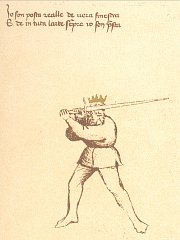Fiore dei Liberi : "Flos Duellatorum", 1410
A Brief Comparative Analysis of the Treatises
The Pisani-Dossi version, the most popular and widely accessible version on the Internet for more than ten years, has a prologue composed of two portions, the first in Latin, and the second more comprehensive portion “alter prologus” in Venetian dialect of Italian. Its prologue is quite unlike the other two versions, in that it completely devoid of any description of the feats of arms of Fiore's students, and mentions Fiore's career as 50 years as opposed to 40 years in the other two versions. However, only in the Pisani-Dossi version, is a date explicitly stated. Fiore wrote that he started his composition on February 10, 1409 (1410 using the modern calendar) and alludes to taking approximately six months to complete. Was the difference in the years of Fiore's career an error in the other two versions? It can be argued that such a personal detail would hardly succumb to such an obvious error, and therefore, one can postulate that the Pisani-Dossi version was composed approximately 5 to 10 years after the completion of the Getty's and Morgan's versions, meaning the Getty's and the Morgan's versions were written sometime after the turn of the 14th century. This debate continues with vigour in the historical community and further discussion or research on this particular subject is outside the scope of this web content.
Of the three versions, the Getty's offers the most detailed paragraphs accompanying the illustrations, followed by the Morgan's with a slightly abbreviated text. To add, the illustrations found in the Getty's and Morgan's are less “animated” like than the illustrations found in the Pisani-Dossi. To add, the contents of the Morgan, despite being more similar to the Getty's version, does not cover the entire art as found in the Getty's, with significant portions not included such as the “abrazare” (grappling) and “daga” (dagger) sections found in both the Pisani-Dossi and Getty's. A comparison between the posta de fenestra depicted in the Getty's and the Pisani-Dossi is provided below.
 |
Getty (left):
Questa si è posta di finestra che di malizie e / ingani sempre la è presta. E de covrir e / de ferire ella è magistra. E cum tutte guardie / ella fa questione e cum le soprane e cum le terrene. / E d'una guardia a l'altra ella va spesso per inga / nar lo compagno. E a metter grande punte / e saver romper e scambiare quelli zoghi / ella pò ben fare.
- posta de finiestra instabile-
Pisani-Dossi (right):
Io son posta realle de uera finestra / E de in tuta l'arte sempre io son presta. |
 |
| folio 23v, "posta di fenestra" MS Ludwig XV13 (codice "GETTY") |
carta 18a, "posta di fenestra" Flos Duellatorum (Pisani-Dossi MS) |
The translation of the text accompanying the Getty's posta di finestra depicted above in the table is
"This is the posta of the window that is quick to be malicious and deceive and it is master of wounding and covering; and it questions (challenges) all the guards both high and low. And it often moves from guard to guard to deceive the companion and to give grand thrusts and knows how to break them and exchange them. Those plays it can do well." - guard of the window unstable -.
The translation for the text accompanying the Pisani-Dossi posta de fenestra in the table above is: "I am in the noble guard of the true window And in the entire art I am always quick."
The difference between the Getty's and Pisani-Dossi versions of the treatise are clearly evident, however, during the course of research and study of Fiore's treatise, it was prudent to study all three versions to ensure that a complete picture of the art was understood. There is not a 100% mapping between the techniques and plays depicted in the Pisan-Dossi with the Getty's version and therefore, a complete examination of the different versions was necessary.
There are four known versions of Fiore's work, so named by the collection the treatise resides. The four versions are:
- Fior di Battaglia, MS Ludwig XV13 (codice "GETTY") located in the J. Paul Getty Museum, Los Angeles, USA;
- Fior di Battaglia: MS M.383 (codice "MORGAN") - The Pierpont-Morgan Library, New York City, USA;
- Flos Duellatorum (Pisani-Dossi MS): F. Novati, Flos duellatorum: Il Fior di battaglia di maestro Fiore dei Liberi da Premariacco (Bergamo, 1902) (which is the source of this online presentation),
- Florius de arte luctandi: MSS LATIN 11269, Bibliothèque nationale de France (BnF).
AEMMA has both electronic and hard copies of the first three versions, including an original 1902 publication (F. Novati, Flos duellatorum: Il Fior di battaglia di maestro Fiore dei Liberi da Premariacco (Bergamo, 1902)) presented to AEMMA's founder, David M. Cvet as a gift by an official of the village of Premariacco, Friuli, Italy in 2005, and high-resolution digital images of the Getty's version purchased and acquired from the J. Paul Getty Museum, Los Angeles, USA, however, these high-resolution images remains available only internally at AEMMA for study due to restrictions of copyright enforced by the Getty Museum.
The study, examination and research of Fiore's treatises is an ongoing project and probably will never end. Enhanced interpretations, the application of the techniques described into practice and the validation of those techniques through their employment in fighting engagements will continue to enhance our understanding of this most detailed of martial art treatises.
Further details of a comparative analysis between the treatises can be read in an article entitled "A Brief Examination of Fiore dei Liberi's Treatises Flos Duellatorum & Fior di Battaglia" published in the Journal of Western Martial Art.
Overview | About Fiore | Comparative Analysis | Online and Printable Resources | Fiore Publications | Flos Duellatorum

